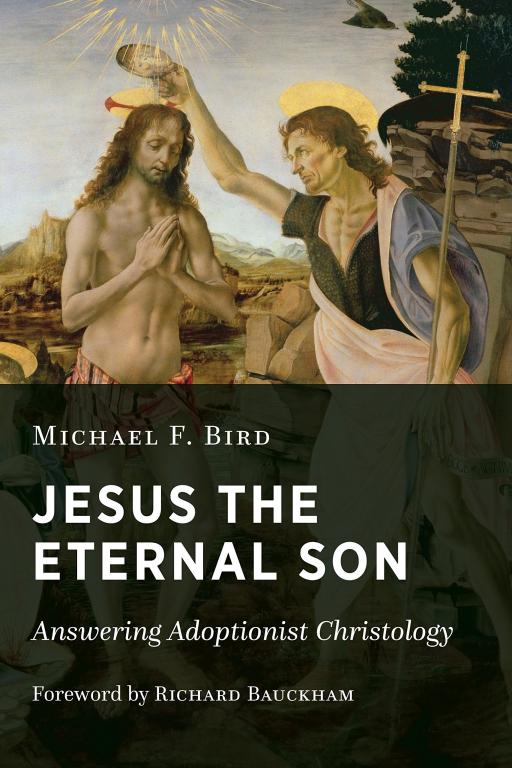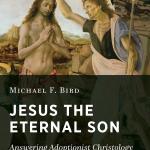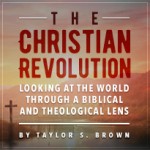
Hello readers! And welcome back to my chapter-by-chapter coverage of Michael Bird’s book, Jesus the Eternal Son: Answering Adoptionist Christology. As usual, life circumstances prevented me from getting this post out in a timely fashion. This time though, it was the positive of having my two best friends from seminary come and visit me for Easter; much preferred to my computer being out for repairs. Also there was the usual mishmash of work and the ease of watching Netflix versus sitting down to write. But I digress.
With the third chapter of the book, “The Gospel of Mark, Monotheism, and Deification,” Bird begins to wade into one of the New Testament books most often put forward as supporting a full-fledged adoptionist Christology: the Gospel of Mark. While the previous chapter covered a few key passages from Paul and Acts that seem to support an adoptionist Christological framework (read contextually and holistically, Bird persuasively argues that they do no such thing), with this chapter, Bird dives headlong into debates surrounding seeming parallels in Mark’s Gospel to Hellenistic accounts of deified heroes, demi-gods, and emperors. It is these parallels that are often brought forward as evidence that the earliest Christology was adoptionist in nature.
If Mark’s gospel is the earliest gospel written (circa 65-70 AD), and if Mark builds his Christological portrait of Jesus upon the existing literary parallels of Hellenistic heroes (such as Heracles) and Roman emperors (such as Caesar Augustus) who were supposedly exalted to the status of divinity on account of their virtue (e.g., Heracles’s slaying of the Nemean lion or Augustus’s status as son of the divinized Julius Caesar), then it is not a far step to show that Jesus too was a mere mortal who was adopted and divinized into divine sonship, albeit in Jewish form. Thus the logic of such adoptionist interpretations of Mark goes. And of course, Bird argues—again, persuasively so, in my opinion—that such a reading of Mark is incorrect.
Methodology, Mark’s Christology, and Avoiding “Parallelomania”
Before diving into the depths of ancient Hellenistic (and Hellenistic Jewish) conceptions of deification, Bird first makes an important methodological observation about literary parallels in texts in general, and in biblical texts in particular. While there are certainly literary parallels present between Mark’s Gospel and various Greco-Roman works (the most obvious example is that Mark wrote his gospel in the general literary format of a Greco-Roman biography), we must be careful to not mistake such parallels as having a genealogical relationship. Put more simply, just because similarities exist between two pieces of literature, that does not at all necessitate that one borrowed directly from the other. They could simply be written within the same socio-historical milieu, wherein given literary genres and forms are used to communicate. The genre or format may be similar, but the actual content is usually vastly different. To quote Bird at length:
Quite clearly the Gospel of Mark cannot be reduced to the generic category of a Hellenistic etiology of a semi-divine hero, but neither can it be absolutely compartmentalized from Hellenistic literature. On the one hand, Mark’s story of Jesus is overwhelmingly shaped by Jewish texts like Dan 7, Pss 2 and 110, as well as Isaiah. As a result, Mark’s Gospel is effectively a Greek version of a Jewish-Christian narration about Jesus, the Messiah and Son of God. In other words, Mark is telling a very Jewish story, shaped principally by Jewish Scriptures, and consequently has a very Jewish ambience. If Mark is portraying Jesus as “divine,” it will be in a very Jewish way. But on the other hand, Mark’s story of Jesus was not written amidst a Judaism that was neatly insulated from Hellenism. [Martin] Hengel demonstrated—with remarkable success—that Hellinistic Judaism rather than pure paganism shaped Christian constructions of Jesus, so that there was no “syncretistic paganization of primitive Christianity”¹ (p. 36)
¹Martin Hengel, Son of God: The Origin of Christology and the History of Jewish-Hellenistic Religion, trans. John Bowden (Philadelphia: Fortress, 1976), 18
The upshot of this is that the influences and content that Mark drew upon to write his gospel are complex and interwoven (p.38). Just as it is incorrect to say that Mark is solely influenced by a “pure” non-Hellenized Second-Temple Judaism, it is equally wrong to say that Mark is an imitation Greco-Roman accounts of divinized heroes, demi-gods, and emperors. The parallels that exist between Mark’s account of Jesus and non-Jewish Greco-Roman documents are parallels of analogy, not genealogy. Again, Bird:
We should repeat the caveat that analogy does not mean genealogy and be aware of the danger of “parallelomania,” where we endlessly make comparisons between texts and say that this Markan pericope [a given unit of text] is really just the same as that Homeric unit or that Plutarchan anecdote. Exegesis by parallelism, yields an approach that tends to flatten out the distinctive features of texts and treats them as little more than slight variations of a singular literary phenomenon. (p. 37 note 10)
Avoiding falling into a morass of “parallelomania” is one of the fundamentals of biblical interpretation (it’s also good advice for reading non-biblical texts). More importantly though, it is a key methodological precept for reading Mark’s Christology on its own terms.
Deification and Exaltation in the Greco-Roman and Jewish Worlds
Having put forward a key methodological prescript in the first part of the chapter, Bird proceeds to move into a survey of the various ways that heroes, demi-gods, emperors, and angelic entities could be exalted in the ancient world. As Bird observes, the idea that a mere human could be elevated to a divine status developed out of mythic tales of great heroes like Heracles and Romulus. This mythic aspect began to enter into the realm of history with Greek rulers, finding its most notable example in the person of Alexander the Great in the 4th century BC. Alexander not only began to style himself as a son of Zeus while he was alive (and thereby not-so-subtly modeling himself after Heracles), he also made it quite clear that he expected to be fully divinized after his death. Alexander even outright requested worship in several of his conquered territories. And indeed, Alexander’s established cult lasted for some time after his early death in 323 BC (p. 39).
The later imperial cult in Rome would take some notes from Alexander’s cult, while at the same time putting its own twist on human deification. The subject of emperor worship is long, complex, and cannot be adequately surveyed here. Suffice it to say though that by the time of the Julio-Claudian emperors (e.g., the first Roman imperial dynasty established by Caesar Augustus), the notion that emperors were to be worshiped during their lifetimes—usually more so in the eastern imperial provinces, rather than Rome itself—and then were given full divine honors after their death was largely cemented.
This usually took the form of the reigning emperor declaring his predecessor father as a god. As already noted, the most notable example of this pattern comes in the form of Caesar Augustus, who had his adoptive father Julius Caesar (he of Shakespearean “Et tu Brute?” and cheap, $5 large pizza fame) posthumously declared a god. This in turn, gave Augustus the right to claim the status as a “son of a god” and eventually to gain full godhood after his death. And thus the pattern went with other emperors (pp. 40-41).
Despite this model of imperial apotheosis, Bird makes the key observation that divinized emperors were not on the same level of “divinity” as the non-human gods like Zeus, Poseidon, and Athena. Within the complex structure of ancient Greco-Roman paganism, there was a stratification of divinity. A deified emperor, while still a god in the technical sense, was nowhere near the same level as the non-human gods. Zeus and Poseidon (or Jupiter and Neptune, if you prefer the Latin names) were always above a divinized Augustus. For many ancient pagans, divinity was less about essence (what a god is) and more about “honor, status, and power” (p. 41). Another key component of this pagan milieu was the element of benefaction. There was a an expectation that the gods would provide protection, sustenance, stability, etc. to Rome in return for Roman worship. The upshot of all of this (which, again, is criminally under-explained on my part) is as follows:
Divinity here is primarily about status while cultic worship is the reciprocal response from those who enjoy the emperor’s benefits. In other words, the highest form of patronage required the highest form of praise in return, namely, divine worship. (p. 43)
Of course, not everyone bought into the notion of imperial apotheosis and deification. While it is was a given that Jewish thinkers would balk at the idea of a mortal man rising to the status of a god, there were also more than a few pagan thinkers who scoffed at the idea. The Cynic philosopher Diogenes derided Alexander’s claims to godhood. Tacitus scoffed at Augustus’s “divine” status. Dio Cassius mocked the idea of the mistress of Caligula (the crazy emperor who appointed his horse to the Senate) being declared a goddess. The famed Stoic thinker Seneca lampooned not only the emperor Claudius’s supposed divinization, but also the whole system of deification itself (pp. 43-45). Other examples could be brought forward, and Bird does so in detail in this section of the book.
For our purposes here though, the main takeaway is that the notion of human apotheosis and divinization was far from an uncontested idea in the Greco-Roman world. While the reasons for this are complex, one of the big factors was that divinity was “absolutized” by many pagan thinkers. As we have already seen, divinity existed on a stratified spectrum within the milieu of ancient paganism; “god” was not a monolithic term. As Bird notes:
Divinity in Greco-Roman religion was a spectrum. One could be divine in relation to a group of worshippers. Yet, there remained fundamental differences between humans and the eternal gods…there were two classes of gods: the eternals and human immortals installed in heaven by merit. (p. 46)
Thus, the claim to the level of worship on the level of the eternal gods was often viewed as deeply problematic and impious. Caligula received great scorn for equating himself with Zeus/Jupiter, and Augustus received critique from Tacitus for trying to usurp traditional divine honors. The upshot of all of this is that Hellenistic divinization was a very contested category. It was not a universal given even among polytheistic pagans, let alone Hellenistic, Diaspora Jews (who we will see, despite the Greek influence, still remained committed to monotheism). Thus, to say that the model of Hellenistic deification was a natural paradigm to fit the story of Jesus into is quite misguided, and very unlikely (49).
Of course, the Jewish commitment to a rather strict monotheism also worked heavily against the “Jesus-as-divinized-hero” model. While Jewish thinkers under Roman rule would pray to Yahweh for the good of the empire and the good of the emperor, they would not give divine honors to a Roman ruler. While there were some syncretists and pragmatists who broke with traditional monotheism, these were always outliers. The vast majority of Jews—both in Judea and in the Diaspora—did not venerate supposedly deified humans and only worshipped the one God of Israel (pp. 50-51).
Of course, the big question that many adoptionist proponents bring forward is that of the various heavenly intermediary figures that existed within the matrix of Second Temple Jewish belief. While figures such as the angel Metatron (who, despite the name, is not related to the leader of the Decepticons), the “Son of Man” in Enochic literature, exalted human figures like Moses in the book of Sirach, and humans assumed into heaven such as Enoch and Elijah, seem to come close to the idea of divinization, in the end they all still fell short of actually being worshipped in the mainstream of Jewish practice and belief.
Indeed, it was still Yahweh alone who received worship as divine, even if all these other figures elicited awe and admiration. This creational monotheism (to borrow the phrase from N.T. Wright) allowed for a variety of heavenly and angelic entities within the cosmos. Many held great power and prestige, and could have easily been mistaken for gods by pagan observers. But in the end they were still created entities, beings who found their source in the one, eternal Creator God. There may have been innumerable kinds and hierarchies of heavenly beings, but there was still only one true God (pp. 51-59). Bird on the matter:
With those caveats [about a small minority of Diaspora Jews who capitulated to paganism] in mind, it appears to me that the Jewish monotheism reflected in the New Testament and in Second Temple Jewish literature more generally tends to absolutize the distinction between God on the one hand and lesser heavenly beings and the created world on the other hand. While there are heavenly and supernatural beings such as angels and spirits, and although exalted human figures are often treated inclusively within divine activity and receive a type of obeisance, they do not encroach on God’s ultimate power and superlative status. (pp. 53-54)
This strict form of creational monotheism is prevalent in the two most important Hellenistic Jewish writers of the period: Philo of Alexandria and Josephus. Despite both of them being thoroughly ensconced within the Greco-Roman world, neither gave up their creational monotheism. Indeed, Philo, who had fully imbibed the Platonic philosophy of Alexandria, said derisively of the idea of human divinization: “Sooner could God change into a man than a man into God” (Legat. 118) (pp. 56-57).
So what does all this mean in relation to the question of Christ’s divinity and the adoptionist model? Well, if human divinization was contested within the pagan world, and vehemently opposed within Hellenistic Judaism, then the thesis that as Jewish an author as Mark could present Jesus as a divinized human is quite implausible. As Bird notes, in Mark’s Gospel, clear markers of Jewish monotheism are repeatedly affirmed: the Shema (12:28-34), God’s sole prerogative to forgive sins (2:7), God alone as being good (10:18), and so on. The Jesus of Mark’s Gospel is himself a very strict monotheist (e.g., 1:35; 11:22; 13:19; 15:34, and many others). Thus, Mark as a Jewish Christian, existing within the matrix of strictly monotheistic Second Temple Judaism would have found it, “singularly difficult to imagine a human being elevated to divine status and power” (p. 60). Not only does this point against an adoptionist reading built upon models of Greco-Roman deification, it actually points toward a form of incarnationalism. If Mark almost certainly did not view Jesus as a creature—either human or heavenly—deified to the status of God (for even the highest archangels could not approach the absolutized status of the one Creator God), and yet still ascribed to him roles and powers that only the God of Israel held, we might begin to infer that Mark viewed Jesus as sharing in the unique divine identity and essence of the one Creator God. It might be that Mark’s Jesus may just be God become man, instead of a mere man who became God. We will see what Bird’s analysis reveals in the next installment of this series.
Finally dear readers, if you’ve made it this far in this series of posts kudos to you! This is pretty heady stuff, but I think it is endlessly fascinating and incredibly important. If you haven’t already, I’d highly recommend buying a copy of the book. I am doing it a great injustice by merely hitting a few of the high points of Bird’s arguments. He really is a great scholar and writer, and if you like the preview I have been giving you in these posts, consider investing in his work for yourself.
Thanks again for reading and as always,
Soli Deo Honor et Gloria











